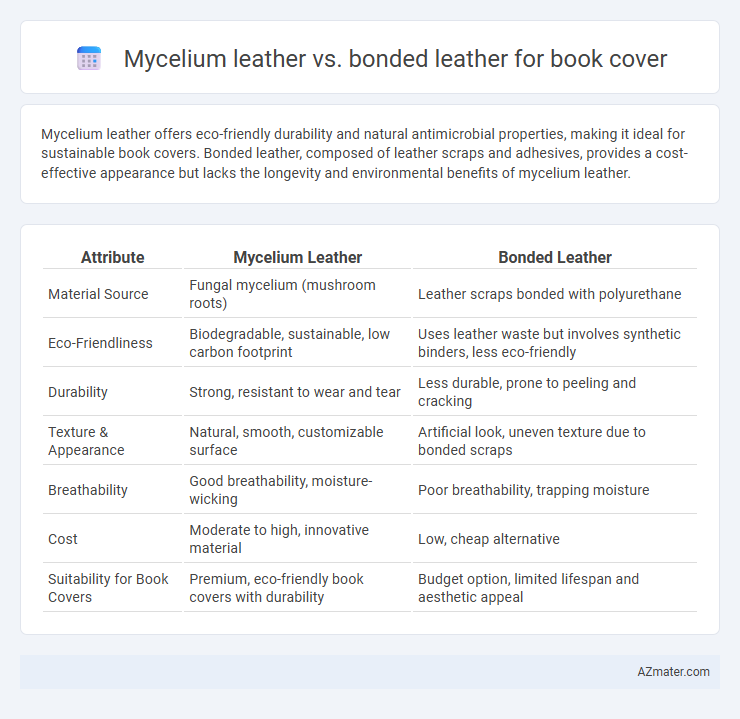Mycelium leather offers eco-friendly durability and natural antimicrobial properties, making it ideal for sustainable book covers. Bonded leather, composed of leather scraps and adhesives, provides a cost-effective appearance but lacks the longevity and environmental benefits of mycelium leather.
Table of Comparison
| Attribute | Mycelium Leather | Bonded Leather |
|---|---|---|
| Material Source | Fungal mycelium (mushroom roots) | Leather scraps bonded with polyurethane |
| Eco-Friendliness | Biodegradable, sustainable, low carbon footprint | Uses leather waste but involves synthetic binders, less eco-friendly |
| Durability | Strong, resistant to wear and tear | Less durable, prone to peeling and cracking |
| Texture & Appearance | Natural, smooth, customizable surface | Artificial look, uneven texture due to bonded scraps |
| Breathability | Good breathability, moisture-wicking | Poor breathability, trapping moisture |
| Cost | Moderate to high, innovative material | Low, cheap alternative |
| Suitability for Book Covers | Premium, eco-friendly book covers with durability | Budget option, limited lifespan and aesthetic appeal |
Introduction to Alternative Leathers for Book Covers
Mycelium leather, derived from mushroom roots, offers a sustainable and biodegradable alternative to traditional bonded leather, which combines leather scraps with synthetic materials. Mycelium provides a unique texture and excellent durability, making it ideal for eco-friendly book covers, whereas bonded leather often lacks longevity and can peel over time. Choosing mycelium leather supports environmentally conscious production and enhances the tactile experience of bookbinding.
What is Mycelium Leather?
Mycelium leather, derived from the root structure of fungi, offers a sustainable and biodegradable alternative to bonded leather, which is made by fusing leather scraps with adhesives and synthetic materials. Unlike bonded leather, mycelium leather provides superior breathability, durability, and eco-friendly qualities, making it ideal for premium book covers seeking both aesthetic appeal and environmental responsibility. Its natural origin and customizable texture ensure a unique, high-quality finish that outperforms synthetic composites commonly used in bonded leather products.
What is Bonded Leather?
Bonded leather is made by combining shredded genuine leather fibers with a polyurethane or latex binder, resulting in a material that mimics the look and feel of real leather at a lower cost. This composite material lacks the durability and natural texture of full-grain or top-grain leather, making it less resilient for book covers that require long-term wear resistance. In contrast, mycelium leather, derived from fungal mycelium, offers a sustainable and eco-friendly alternative with improved durability and a distinctive organic texture suitable for premium bookbinding.
Sustainability Comparison: Mycelium vs Bonded Leather
Mycelium leather, derived from mushroom roots, offers a biodegradable and renewable alternative to bonded leather, which is often made from shredded leather scraps combined with synthetic binders, resulting in limited recyclability and potential environmental harm. The production of mycelium leather requires fewer resources, emits lower greenhouse gases, and supports a circular economy, whereas bonded leather involves chemical processing and contributes to landfill waste. Choosing mycelium leather for book covers significantly enhances sustainability through eco-friendly sourcing and reduced toxic byproducts compared to bonded leather.
Durability and Longevity in Book Covers
Mycelium leather offers superior durability and longevity for book covers due to its natural resistance to wear, moisture, and tearing compared to bonded leather, which tends to deteriorate quickly as it is made from leather scraps mixed with adhesives. Mycelium's fibrous structure enhances flexibility and strength, preventing cracking and peeling often seen in bonded leather covers after prolonged use. This sustainable alternative not only maintains its aesthetic appeal over time but also provides eco-friendly benefits while outperforming bonded leather in preserving book cover integrity.
Aesthetic and Tactile Differences
Mycelium leather offers a unique, natural texture with subtle organic patterns, providing a modern and eco-friendly aesthetic compared to bonded leather's more uniform, synthetic look. The tactile experience of mycelium leather is softer and more breathable, mimicking genuine leather's flexibility, whereas bonded leather often feels stiffer and less responsive to touch due to its composite nature. Choosing mycelium leather enhances the sensory appeal and visual sophistication of book covers, ideal for premium, sustainable designs.
Environmental Impact of Production Processes
Mycelium leather, derived from fungal biomass, offers a significantly lower environmental impact compared to bonded leather, which is made by compressing leather scraps with synthetic binders. The production of mycelium leather requires less water, emits fewer greenhouse gases, and avoids toxic chemical treatments common in bonded leather manufacturing. Choosing mycelium leather for book covers supports sustainability by reducing resource consumption and facilitating biodegradable, eco-friendly disposal.
Cost and Accessibility for Publishers
Mycelium leather offers an eco-friendly yet relatively high-cost alternative for book covers, appealing to publishers aiming for sustainable materials but facing budget constraints. Bonded leather remains a more affordable and widely accessible option, commonly used due to lower production costs and easier procurement. Publishers prioritizing cost-efficiency and immediate availability often prefer bonded leather despite its lesser environmental benefits compared to mycelium leather.
Consumer Preferences and Market Trends
Mycelium leather offers eco-conscious consumers a sustainable and cruelty-free alternative to traditional bonded leather, driving increased demand in the book cover market. Growing awareness of environmental impact and preference for biodegradable materials have positioned mycelium leather as a premium choice among millennials and Gen Z buyers. Market trends indicate a shift towards plant-based textiles, with mycelium leather gaining traction for its durability, unique texture, and reduced carbon footprint compared to bonded leather made from leftover animal hides and synthetic binders.
Future Prospects in Book Cover Materials
Mycelium leather offers sustainable, biodegradable properties with a lower environmental impact compared to traditional materials, making it a promising candidate for future book covers. Bonded leather provides cost-effective appearance but lacks durability and eco-friendliness. Advancements in mycelium technology suggest broader adoption in bookbinding, driven by increasing demand for sustainable, ethical materials in publishing.

Infographic: Mycelium leather vs Bonded leather for Book cover
 azmater.com
azmater.com